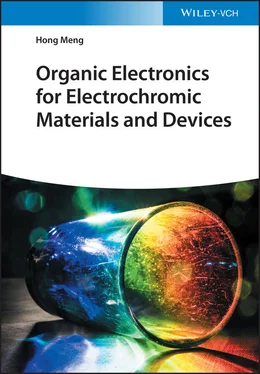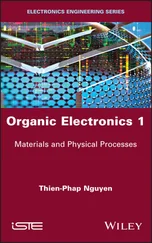19 14 Commercialized OEC Materials and Related Analysis of Company Patents14.1 General Introduction 14.2 Gentex Corporation 14.3 Ricoh Company, Ltd. 14.4 Canon Inc. 14.5 BOE Technology Group Co., Ltd. and OPPO Guangdong Mobile Communications Co., Ltd. 14.6 Other Important Enterprises 14.7 Conclusion References
20 15 Main Challenges for the Commercialization of OEC15.1 Introduction 15.2 The Long‐Term Stability of OEC Materials 15.3 The Mechanical Stability of OEC Devices (Encapsulation Technology) 15.4 Large‐Area Process Technology: Spray Coating and Roll‐to‐Roll Processes 15.5 Conclusions and Perspective References
21 Index
22 End User License Agreement
1 Chapter 2 Table 2.1 Polymer hosts generally studied with the examples of gel polymer el... Table 2.2 Examples of self‐healingand cross‐linking polymer electrolyte compl... Table 2.3 Comparison of the Li +conductivities of some reported solid pol... Table 2.4 Composition and performance of ionic liquid electrolytes.
2 Chapter 4Table 4.1 Recent review and book chapter about viologen‐based EC materials an...Table 4.2 Optical and colorimetric properties of selected viologen radical ca...Table 4.3 Optical and electronic properties of the chalcogen‐bridged viologen...Table 4.4 Representative of composition of ECD.
3 Chapter 5Table 5.1 Most commonly used synthetic procedures for PB thin films.
4 Chapter 6Table 6.1 Electrochromic properties of N‐substituted polypyrrole derivatives.Table 6.2 Electrochromic properties of 3,4‐substituted polypyrrole derivative...
5 Chapter 8Table 8.1 Summary of the electrochromic behavior of the mentioned electropoly...
6 Chapter 9Table 9.1 The apparent ion diffusion coefficients ( D app,CV) (cm 2/s) of Na +...
1 Chapter 1 Figure 1.1 Solar irradiance spectrum above atmosphere and at the surface of ... Figure 1.2 The scheme of three types of electrochromic devices. Figure 1.3 The roadmap of EC materials development. Figure 1.4 The spectroelectrochemistry (SEC) of a black‐to‐transmissive EC m... Figure 1.5 (a) The electrochromic contrast of a small molecule EC material.... Figure 1.6 The switching time of EC materials. (a) Electrochemical switching... Figure 1.7 The calculation of Q d. Figure 1.8 Different types of CE value of the same EC materials. Figure 1.9 Open‐circuit memory tests of PBOTT‐BTD spray coated on an ITO‐coa... Figure 1.10 Charge density (a) and transmittance (b) variation curves of ECD... Figure 1.11 Recommended testing guidelines for EC windows for exterior archi...
2 Chapter 2 Figure 2.1 Main concerns in electrolyte. Figure 2.2 Schematic showing printing of colored‐to‐clear electrochromic pap... Figure 2.3 A fabrication process for lateral paper ECDs showing inkjet‐print... Figure 2.4 Synthetic routes for P[S‐r‐VBMI][PF 6]. Figure 2.5 Synthetic routes for (PS‐b‐PMMA) 18. Figure 2.6 (a) The mechanism of self‐healing process for electrochromic PPFM... Figure 2.7 Pictorial model of a preparation of a cross‐linked polymer. Figure 2.8 (a) General synthetic routes for P(NIPAM‐fv [DAV]) IL gels and P(... Figure 2.9 The evolutions of morphology of ceramic filler in SCEs. Figure 2.10 A switchable single‐molecule electrochromic device derived from ... Figure 2.11 Schematic representation of the synthesis of PIL‐b‐CD and PIL‐Fc... Figure 2.12 An ECD structure containing a gel electrolyte composition combin... Figure 2.13 An electrochromic device containing DNA‐based electrolyte.
3 Chapter 3 Figure 3.1 Commonly utilized device structure for small molecule electrochro... Figure 3.2 Technology development of small molecule electrochromic materials... Figure 3.3 General structure for violene‐type electrochromics. Figure 3.4 Electrochromic mechanism of violene–cyanine hybrid material. Figure 3.5 Structure of cyanine–cyanine hybrid materials. Figure 3.6 Structure of cyanine–cyanine hybrid materials. Figure 3.7 Structure of the cyanine–cyanine hybrid with a cyanine unit at on... Figure 3.8 Mechanism of violene–cyanine hybrids. Figure 3.9 Structure, absorption spectra, and images of colored cells. Figure 3.10 Structure of the TP film. Figure 3.11 Structure of biphenyl ester compounds with larger conjugated sys... Figure 3.12 Structures of oligothiophene derivatives, 5,5″‐dicyano‐2,2′: 5′,... Figure 3.13 (a) Molecular structures of OHC‐3T‐CHO and X‐T. (b–d) Schematic ... Figure 3.14 Mechanism of oligothiophene derivatives. Figure 3.15 (a) Molecular structures of 3TB, 3EB, 3ETB, and 3TB‐4EDOT. (b) P... Figure 3.16 (a) Molecular structures of 1EDOT‐2B‐COOCH 3, 2EDOT‐2B‐COOCH 3, ED... Figure 3.17 Structure of common isophthalate derivatives. Figure 3.18 (a) Electrochromism of 5‐substituted isophthalate derivatives an... Figure 3.19 Calculated HOMO, LUMO, and LUMO + 10 of the reduced species of M... Figure 3.20 Known reduction process of nitrobenzene. Figure 3.21 (A) Electrochromism of 5‐substituted isophthalate derivatives (w... Figure 3.22 Structures of Bis‐isophthalate derivative IS1‐6. Figure 3.23 UV–visible spectra and photos of displayed colors before and aft... Figure 3.24 Structure of the TP film. Figure 3.25 Optical (at 530 nm) (top) and electrical current (bottom) respon... Figure 3.26 (a) Structure of eleven esters synthesized and (b) photographs o... Figure 3.27 (a) Cyclic voltammograms of diesters and (b) in situ electrochem... Figure 3.28 Structure, synthesis, and properties of EC materials based on ph... Figure 3.29 Structure and UV spectra of conjugated anodically coloring elect... Figure 3.30 Synthesis and structures of azobenzene‐4,4′‐dicarboxylic acid di... Figure 3.31 Electrochromic mechanism of ADDEDs. Figure 3.32 Structure of pyridinium electrochromic materials. Figure 3.33 Molecular structures of electrochromic 2,4,6‐triphenyl‐1,3,5‐tri...Figure 3.34 Synthetic scheme for methyl ketone and (A) absorption spectra of...Figure 3.35 The structures of seven methyl ketone molecules and the colors o...Figure 3.36 (a) The synthetic route of M5; (b) The HOMO (bottom) and LUMO or...Figure 3.37 The electrochromic mechanism of M5 with a one‐electron reduction...Figure 3.38 The structure, electrochromic mechanism, and photographs of the ...Figure 3.39 (a) Lactone ring‐opening–closing reaction of fluoran dye. (b) Th...Figure 3.40 Mechanism of the reaction.Figure 3.41 Mechanism of imaging using a leuco dye on a mesoporous TiO 2elec...Figure 3.42 (A) The switch mechanism of fluorescein with electro‐reduced p ‐b...Figure 3.43 (a) The fluorescence switching mechanism induced by p ‐BQ as an e...Figure 3.44 Bonding alteration process of Rh–N via bond‐coupled electron tra...Figure 3.45 (a) Bonding alteration process of Rh–N via bond‐coupled electron...Figure 3.46 (a) Molecular structures of RHMA‐M1–RHMA‐M6 (the colored shading...Figure 3.47 The switch mechanism of fluorescein with electro‐reduced p ‐benzo...Figure 3.48 (a) Structure of DMCS‐TPA and BMBCP and (b) photographs of DMCS‐...Figure 3.49 (a) Chemical structures of ambipolar EC materials BDP1–BDP6, (b)...Figure 3.50 (a) Schematic diagram of color change for ambipolar materials, (...Figure 3.51 (a) Structures of Thiele's hydrocarbon and bridged tetra‐aryl‐ p ‐...
4 Chapter 4Scheme 4.1 Development routes of viologen.Figure 4.1 Viologens in three forms: R 1and R 2refer to the substituent at n...Figure 4.2 Adsorption of viologen on the surface of nanocrystalline electrod...Figure 4.3 Structure of ester viologen.Figure 4.4 Color coordinates of asymmetric viologens device. aTransmittance ...Figure 4.5 Different devices and color coordinates.Figure 4.6 Normalized absorption and emission spectra of H 2TTz 2+, Me 2TTzFigure 4.7 Fluorescence quenching.Figure 4.8 Multilayer PDI‐MV device.Figure 4.9 Cyclic voltammograms of a 10 bilayer film at various scan rates a...Figure 4.10 The structure of photographs device.Scheme 4.2 The synthesis route of phosphoryl‐bridged pyridiniums.Figure 4.11 (a) Three‐electrode liquid crystalline cell. (b) Optical absorpt...Figure 4.12 (a) Fluorescence spectra of the applied voltage of the gel of 10...Figure 4.13 Side‐chain viologen‐based polymers.Figure 4.14 Spectral absorption of the device.Figure 4.15 Reversible photochromism spectrum.Figure 4.16 Synthesis of polyviologens via Menshutkin reaction.Figure 4.17 Synthesis of P(NIPAM‐DAV) IL gels and P(NIPAM‐BVIm‐DAV) gels....Figure 4.18 Thermochromic and electrochromic effect.Figure 4.19 Illustration of five‐layer classic structure.Figure 4.20 Illustration of simple sandwich structure.Figure 4.21 Illustration of cathode–anode separation structure.Figure 4.22 Illustration of reflective device structure.Figure 4.23 The structureof common redox mediators.Figure 4.24 Combination of GQDs anion and viologen.Figure 4.25 Photograph of RGO film in ethyl viologen device.Figure 4.26 (a) Formation of gel electrolytes based on MOP chemistry and (b)...Figure 4.27 Self‐healing electrolyte gel.Figure 4.28 (A) Dimerization behavior of radical cation. (B) Absorbance spec...Figure 4.29 The representative structure and components of ECD.
Читать дальше












